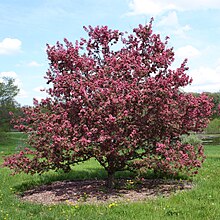
Back Malus AN تفاح (جنس) Arabic تفاح (جنس) ARZ ГӀеч AV Alma (cins) Azerbaijani Алмағас Bashkir Яблыня Byelorussian Яблыня BE-X-OLD Ябълка (род) Bulgarian Avalenn Breton
- "Wild apple" redirects here. In Australia, this may refer to the unrelated Pouteria eerwah.
| Malus | |
|---|---|

| |
| Malus ‘Purple Prince’[1] | |
| Scientific classification | |
| Kingdom: | Plantae |
| Clade: | Tracheophytes |
| Clade: | Angiosperms |
| Clade: | Eudicots |
| Clade: | Rosids |
| Order: | Rosales |
| Family: | Rosaceae |
| Subfamily: | Amygdaloideae |
| Tribe: | Maleae |
| Subtribe: | Malinae |
| Genus: | Malus Mill. |
| Type species | |
| Malus sylvestris Mill. (1768)
| |
| Species | |
|
See text | |




Malus is a genus of about 30–35 species of small deciduous apple trees or shrubs in the family Rosaceae.[2] Other studies say it includes 55 species,[3] including the domesticated orchard apple, or table apple as it used to be called. The other species and subspecies are generally known as "wild apples", "crab apples", "crabapples" or "crabs".
The genus is native to the temperate zone of the northern hemisphere, in Europe, Asia and North America.
Apple trees are small, usually 4–12 m tall when full grown. The leaves are 3–10 cm long, positioned opposite from each other. They have a simple shape with a saw-tooth edge. The flowers come from corymbs, and have five petals, which may be white, pink or red, with usually red stamens that produce lots of pollen, and an ovary which is below them. Flowering takes place in the spring and pollination is by insects (typically bees, which freely visit the flowers for both nectar and pollen).
- ↑ Cirrus Digital Purple Prince Crabapple
- ↑ Sunset Western Garden Book, 1995:606–607
- ↑ Phipps J.B.; et al. (1990). "A checklist of the subfamily Maloideae (Rosaceae)". Can. J. Bot. 68 (10): 2209–2269. doi:10.1139/b90-288.
© MMXXIII Rich X Search. We shall prevail. All rights reserved. Rich X Search